Beskids
The Beskids or Beskid Mountains (Polish: Beskidy, Czech: Beskydy, Slovak: Beskydy, Rusyn: Бескиды (Beskydŷ), Ukrainian: Бескиди (Beskydy)) are a series of mountain ranges in the Carpathians, stretching from the Czech Republic in the west along the border of Poland with Slovakia up to Ukraine in the east.[1]
| Beskids | |
|---|---|
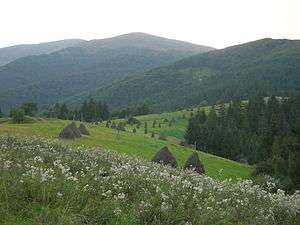 Eastern Beskids in Zakarpattia Oblast, Ukraine | |
| Highest point | |
| Peak | Babia Góra |
| Elevation | 1,725 m (5,659 ft) |
| Coordinates | 48°09′36″N 24°30′01″E |
| Dimensions | |
| Length | 600 km (370 mi) |
| Width | 70 km (43 mi) |
| Naming | |
| Native name | Beskidy (pl) Beskydy (cs/sk) |
| Geography | |
| Countries | Poland, Slovakia, Czech Republic and Ukraine |
| Regions | Silesia, Lesser Poland, Moravia and Carpathian Ruthenia |
| Range coordinates | 49°25′00″N 20°15′00″E |
| Parent range | Western and Eastern Carpathians |
| Borders on | Sudetes and Tatra Mountains |
The highest mountain in the Beskids is Babia Góra, at 1,725 m metres (5,659 ft).
Etymology
The origin of the name beskydy has not been conclusively established. A Thracian or Illyrian origin has been suggested, however, as yet, no theory has majority support among linguists. The word appears in numerous mountain names throughout the Carpathians and the adjacent Balkan regions, like in Albanian bjeshkë. The Slovak name Beskydy refers to the Polish Bieszczady Mountains, which is not a synonym for the entire Beskids but one single range, belonging to the Eastern Beskids. According to another linguistic theory, it may be related to Middle Low German beshêt, beskēt, meaning watershed.[2]
Historically, the term was used for hundreds of years to describe the mountain range separating the old Kingdom of Hungary from the old Kingdom of Poland. In 1269, the Beskids were known by the Latin name "Beschad Alpes Poloniae" (translated as: Beskid Mountains of Poland).[3]
Definition
The Beskids are approximately 600 km in length and 50–70 km in width. They stand mainly along the southern border of Lesser Poland with northern Slovakia, stretching to the Moravia and Czech Silesia regions of the eastern Czech Republic and to Carpathian Ruthenia in western Ukraine. Parts form the European Watershed, separating the Oder and Vistula basins in the north from the Eastern Slovak Lowland, part of the Great Hungarian Plain drained by the Danube River.
Geologically all of the Beskids stand within the Outer Western Carpathians and the Outer Eastern Carpathians. In the west they begin at the natural pass of the Moravian Gate, which separates them from the Eastern Sudetes, continue east in a band to the north of the Tatra Mountains, and end in Ukraine. The eastern termination of the Beskids is disputed. According to older sources, the Beskids end at the source of the Tisza River, while newer sources state that the Beskids end at the Uzhok Pass at the Polish-Ukrainian border.
Subdivisions
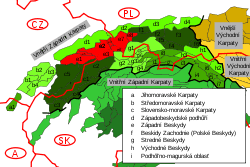
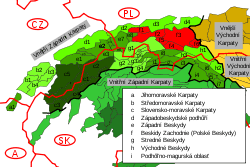
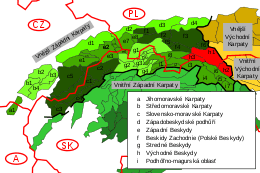
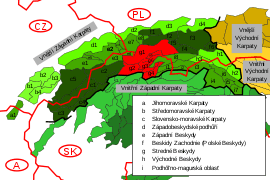
Multiple traditions, languages and nationalities have developed overlapping variants for the divisions and names of the Beskid ranges. According to the divisions of the Carpathians, they are categorized within:
Western Beskids
- Western Beskids (PL: Beskidy Zachodnie, SK: Západné Beskydy, CZ: Západní Beskydy)
- Western section of the Western Beskids:
- Hostýn-Vsetín Mountains (Czech: Hostýnsko-vsetínská hornatina) → e1
- Moravian-Silesian Beskids (Czech: Moravskoslezské Beskydy, Slovak: Moravsko-sliezske Beskydy) → e2
- Turzovka Highlands (Slovak: Turzovská vrchovina) → e3
- Jablunkov Furrow (Czech: Jablunkovská brázda) → e4
- Rožnov Furrow (Czech: Rožnovská brázda) → e5
- Jablunkov Intermontane (Slovak: Jablunkovské medzihorie, Czech: Jablunkovské mezihoří) → e6
- Silesian Beskids (Polish: Beskid Śląski, Czech: Slezské Beskydy) → e7
- Żywiec Basin (Polish: Kotlina Żywiecka) → e8
- Northern section of the Western Beskids:
- Little Beskids (Polish: Beskid Mały) → f1
- Maków Beskids (Polish: Beskid Makowski) → f2
- Island Beskids (Polish: Beskid Wyspowy) → f3
- Gorce Mountains (Polish: Beskidy Zachodnie) → f4
- Rabka Basin (Polish: Kotlina Rabczańska) → f5
- Sącz Basin (Polish: Kotlina Sądecka) → f6
- Central section of the Western Beskids:
- Orava Beskids (SK: Oravské Beskydy) + Żywiec Beskids (PL: Beskid Żywiecki) (the older SK equivalent of Beskid Zywiecki is "Slovenské Beskydy" - Slovak Beskids or "Kysucko-oravské Beskydy" - Kysuce-Orava Beskids) → g1
- Kysuce Beskids (SK: Kysucké Beskydy) +Żywiec Beskids (PL: Beskid Żywiecki) (the older SK equivalent of Beskid Zywiecki is "Slovenské Beskydy" or "Kysucko-oravské Beskydy") → g2
- Orava Magura (SK: Oravská Magura) → g3
- Orava Highlands (SK: Oravská vrchovina) → g4
- Sub-Beskidian Furrow (SK: Podbeskydská brázda) → g5
- Sub-Beskidian Highlands (SK: Podbeskydská vrchovina) → g6
- Eastern section of the Western Beskids:
- Western section of the Western Beskids:
- West Beskidian Foothills, in the Czech Republic and Poland
- Silesian-Moravian Foothills (CZ: Podbeskydská pahorkatina, PL: Pogórze Śląsko-Morawskie) → d1
- Silesian Foothills (PL: Pogórze Śląskie) → d2
- Wieliczka Foothills (PL: Pogórze Wielickie) → d3
- Wiśnicz Foothills (PL: Pogórze Wiśnickie) → d4
Central Beskids
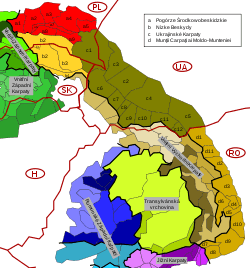
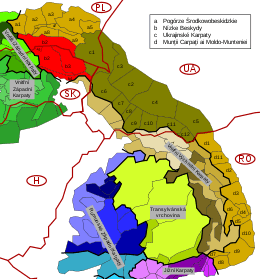
- Central Beskids (PL: Beskidy Środkowe) or Low Beskids (SK: Nízke Beskydy)
- Busov, in Slovakia
- Ondava Highlands (SK: Ondavská vrchovina)
- Low Beskid (PL: Beskid Niski) + Laborec Highlands (SK: Laborecká vrchovina)
- Beskidian Southern Foothills (SK: Beskydské predhorie)
- Central Beskidian Piedmont, in Poland
- Rożnów Piedmont (PL: Pogórze Rożnowskie)
- Ciężkowice Piedmont (PL: Pogórze Ciężkowickie)
- Strzyżów Piedmont (PL: Pogórze Strzyżowskie)
- Dynów Piedmont (PL: Pogórze Dynowskie)
- Przemyśl Piedmont (PL: Pogórze Przemyskie)
- Gorlice Depression (PL: Obniżenie Gorlickie)
- Jasło-Krosno Basin (PL: Kotlina Jasielsko-Krośnieńska)
- Jasło Piedmont (PL: Pogórze Jasielskie)
- Bukowsko Piedmont (PL: Pogórze Bukowskie)
Eastern Beskids

Eastern Beskids are divided into two parallel ridges: Wooded Beskids and Polonynian Beskids.
- Wooded Beskids (PL: Beskidy Lesiste; UA: Лісисті Бескиди)
- Bieszczady Mountains (PL: Bieszczady; UK: Бещади) → c1
- Sanok-Turka Mountains (PL: Góry Sanocko-Turczańskie; UK: Верхньодністровські Бескиди) → c3
- Skole Beskids (PL: Beskidy Skolskie; UA: Сколівські Бескиди) → c2
- Gorgany (PL: Gorgany; UA: Ґорґани) → c4
- Pokuttia-Bucovina Beskids (PL: Beskidy Pokucko-Bukowińskie; UA: Покутсько-Буковинські Карпати) → c5
- Polonynian Beskids (PL: Beskidy Połonińskie; UA: Полонинські Бескиди)
- Smooth Polonyna (UK: Полонина Рівна) → c6
- Polonyna Borzhava (UK: Полонина Боржава) → c7
- Polonyna Kuk (UK: Полонина Кук) → c8
- Red Polonyna (UK: Полонина Красна)→ c9
- Svydovets (UK: Свидівець) → c10
- Chornohora (UK: Чорногора) → c11
- Hrynyavy Mountains (UK: Гриняви) → c12
Infrastructure
The Beskids are currently rich in forest and coal. In the past they were rich in iron ore, with important plants in Ostrava and Třinec – Třinec Iron and Steel Works.
There are many tourist attractions, including historic wooden churches (see Wooden Churches of Southern Little Poland, Carpathian Wooden Churches of Slovakia, and Wooden Churches of Ukraine) and the increasingly popular skiing resorts.
A number of environmental groups support a small but growing population of bears, wolves and lynx in the ecosystem of the Beskidy mountains. The Central Beskids include the Polish Babia Góra National Park and the adjacent Slovak Horná Orava Protected Landscape Area.
See also
References
- Encyclopedia of Ukraine: Beskyds
- Zbigniew Gołąb. The Origins of the Slavs: A Linguist's View. Slavica Publishers, Inc., 1992 p. 342. "The Germanic etymology of Bieszczad // Beskid was proposed by prof. Jan Michał Rozwadowski (1914:162, etc). He derives the variant beščad from Germc. biskaid, which is represented by MLG besche (beskêt) Trennung and by Scandinavian bêsked, borrowed from [...]"
- Kazimierz Zarzycki, Zbigniew Głowaciński (1986): Bieszczady (p. 7)
Sources
- Földvary, Gábor Z. (1988). Geology of the Carpathian Region. Singapore: World Scientific Publishing Company.CS1 maint: ref=harv (link)
- Kondracki, Jerzy (1977). Regiony fizycznogeograficzne Polski. Warszawa: Wydawa Uniwersytetu Warszawskiego.CS1 maint: ref=harv (link)
- Kondracki, Jerzy (1989). Problemy standaryzacji nazw geograficznych. Warszawa: Instytut Geografii i Przestrzennego Zagospodarowania PWN.CS1 maint: ref=harv (link)
- Kondracki, Jerzy (2000) [1998]. Geografia regionalna Polski (2. ed.). Warszawa: Wydawnictwo Naukowe PWN.CS1 maint: ref=harv (link)
- Tasenkevich, Lydia (2009). "Polonynas: Highlands Pastures in the Ukrainian Carpathians". Grasslands in Europe: Of High Nature Value. Zeist: KNNV Publishing. pp. 203–208.CS1 maint: ref=harv (link)
- Filip Świstuń, Galicyjskie Beskidy i Karpaty Lesiste: Zarys orograficzn, Rzeszow 1876.
Gallery
 Map of the Beskid ranges in Slovakia and Poland
Map of the Beskid ranges in Slovakia and Poland- Czantoria, Silesian Beskids
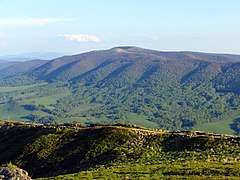 Western Bieszczady
Western Bieszczady Western Bieszczady
Western Bieszczady
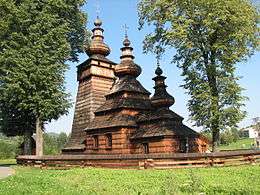 Wooden church in Kwiatoń
Wooden church in Kwiatoń- Wooden church in Hrabova, Moravia (14th - 1564)
_04.jpg) Shepherds in Silesian Beskids
Shepherds in Silesian Beskids
External links
| Wikimedia Commons has media related to The Beskids. |